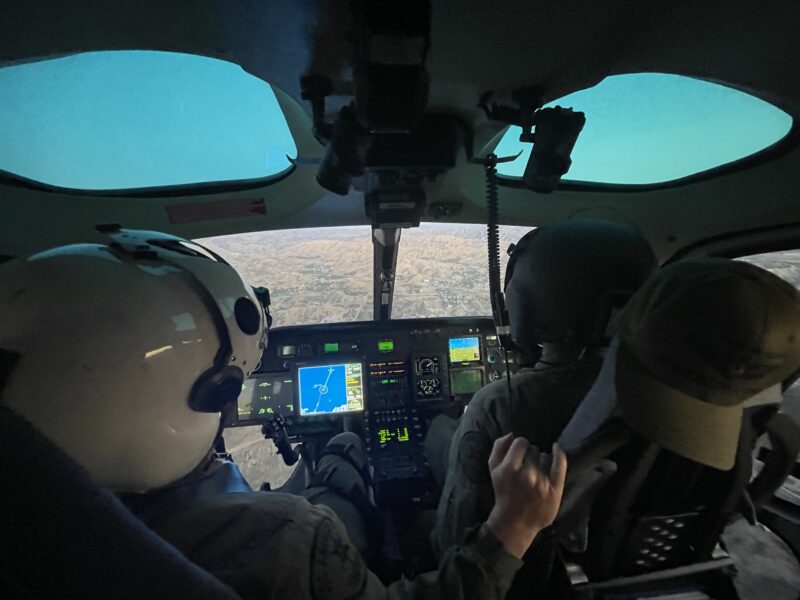From a thousand feet in the air, pilots in the Los Angeles County Sheriff’s Department Aero squadron say they can determine someone’s guilt or innocence based on how a possible subject on the ground responds to their search light shining on them.
Deputy Ted Gomez, while piloting an LASD AS350 B2 on patrol over Lancaster, joked that the powerful search light on the helicopter is their “light of justice,” an allusion to Wonder Woman’s “Lasso of Truth” in the comic books.
If they turn the light on directly pointed down at a suspect, after flying over the location, making a hard left banking maneuver at 100 mph, to begin circling the subject, and the person on the ground does not react, it likely means they’re not worth looking at for an extended period.
But if they shine bright light on the subject, and that person begins to act quickly or nervously drive away — it gives them a better idea on whether this person is worth following.
“I come into work and I have a blast doing this,” Gomez said just before hopping in Air 29 and stashing away his midflight snack of gummy bears. “Who else can say they get to do this ?”
History of Aero Bureau
A terror or an angel from above, depending on who you are, the Los Angeles County Sheriff’s Department Aero Bureau is made up of the men and women piloting the law enforcement helicopters seen regularly in the skies above L.A. County.
In its first iteration in 1926, five pilots made up the “Sheriff’s Aero Squadron,” many of whom flew in an open cockpit biplane and whose “principle activities of the squadron at that time focused on searches for criminal suspects attempting to flee the county or seeking refuge in the hills and canyons surrounding the greater Los Angeles area, mountain searches for missing or stranded hikers, prisoner transportation flights and aerial demonstrations and exhibitions throughout Los Angeles County,” according to LASD’s own recorded history.
Following the Long Beach Earthquake in 1933 — and a group of volunteer pilots carrying a deputy sheriff observer on board in order to provide “timely and valuable damage assessment” of the quake area — the L.A. County Board of Supervisors officially decided to recognize the “Sheriff’s Aero Detail” later that year.


In June 1966, the Sky Knight Helicopter Patrol Program was created in the city of Lakewood and flew regularly scheduled patrols, becoming the first program of its kind in the nation. The Sky Knight program would also make history again, when in 1981 they inducted the first full-time female law enforcement helicopter pilot in the nation’s history.
And now, nearly a century removed from the bureau’s creation and known simply as the LASD Aero Bureau, the patrol consists of a mixture of aircraft — including three fixed wing airplanes, three rescue helicopters and 15 patrol helicopters — that, depending on the aircraft, can assist with medical emergencies, help missing hikers and/or track down criminals.
Despite the expanded responsibilities over the years and different technology and aerospace machine capabilities, the Aero Bureau continues on with the practice of taking to the skies over Los Angeles County, and in all things, assisting those on the ground.

Becoming an LASD pilot
“We listen for high-risk calls and violent crimes in progress: robberies, burglaries, assaults. We’ll help out ground crews with missing persons and hikers,” said Sgt. Pat Morris, who was sitting shotgun in Air 29 with Gomez as his pilot on a recent Friday night with two Signal journalists along as passengers.
Both Morris and Gomez have multiple decades of combined experience working in the Los Angeles County Sheriff’s Department — first starting in custody, then working as deputies in a variety of LASD’s branches, before ultimately making the switch to Aero.
“It’s a totally different perspective, especially when it comes to police work,” said Gomez. “You have to come up here with the experience of a Metro patrol deputy.”
In addition to having to know what the situation on the ground is like, figuring out where and how the “eyes in the sky” should be assisting, being a deputy also assists in knowing the community you’ll be flying over, often at night, according to the pilots. In fact, during their first few months, pilots are told they must use a paper map instead of the onboard GPS system on the off chance that their instruments go down at some point in their careers.
Speaking of becoming a pilot for LASD, Morris and Gomez said the Aero Bureau is one of the most competitive department groups for deputies to apply to and succeed in — having to stand out among hundreds of other applicants each time there’s a new opening.
According to Gomez, not only did he have to apply multiple times to the program, but he also then had to make it through months of training and complete hundreds of hours of flight time. He said about 80% of his class dropped out before becoming an official Aero deputy.


Being an LASD Pilot
A day for Morris and Gomez, they said, when they’re up in the sky, begins at around 4 p.m. in Pomona and the two will be on shift for the next 10 hours. The helicopter they were flying in at the time of this interview was Air 29, which primarily patrols the North County, including the Santa Clarita Valley, Palmdale and Lancaster.
Although they largely spend their time in Lancaster and Palmdale, they say in only a couple of minutes, the two men can respond to a call in any part of their jurisdiction. For instance, at a speed of 130 mph and taking off from the helipad at the SCV Sheriff’s Station, the two began circling the scene of an assault with a deadly weapon in Lancaster within 12-13 minutes from the initial take off.
“We fly for three hours, then we go down for two hours for fuel and eat lunch,” said Morris, adding that they then head back up after their break. “It kind of gives your body a break because you can’t sit there for six hours straight … unless we’re on something major and then we’ve flown seven to eight hours straight before.”
“You’re the one calling out everything, you’re keeping an eye on everything,” said Gomez. “At some point those guys on the ground are probably going to stop chasing them, but we don’t. We will keep following these guys until the wheels fall off.”
According to Morris, the North L.A. County pilots average about 10 calls for service a night, but that wasn’t always the case.


“It’s kind of slowed down right now …. These guys are dealing with a lot of report calls, so they don’t have a lot of time to go out and be proactive, get into chases and stuff,” said Morris. “But back in the day, you know eight to nine years ago, it was probably 18 to 20 calls a night for service.”
“It takes a toll on your body,” Morris added.
The average pilot spends approximately 1,000 hours in the air annually, and because they seemingly feel everything the same way the helicopter feels it, plus being in a fixed position for hours on end, as well as the previous injuries sustained during their careers, new or exasperated hip, knee and joint issues can be common, the two Aero personnel said.
Morris jokingly said he had one pilot that he described as an “old German Shepherd” due to the years of physicality he went through being a helicopter pilot.

But, according to the two men — with one piloting the aircraft and the other controlling the onboard GPS, night vision camera, search light and multiple radio scanner frequencies, among many other responsibilities — they switch up who’s in which seat during the week in order to break up the repetition.
What still surprises Gomez the most over his years as an Aero pilot?
“That it’s me flying a nearly $5 million helicopter and the county trusts me to fly it,” Gomez said jokingly. “We’ll switch up partners or change partners every three months, and every partner, especially the newer guys, they come up and are like, ‘Do you believe they’re trusting us with a $5 million helicopter?’”
But when asked why they go through the stress of daily operating a $5 million piece of equipment, or the competitive application process, or stress on their bodies, both respond that it’s all worth it.
“Like Pat was talking about earlier, it’s nice to be able to help the guys down on the ground,” said Gomez.













